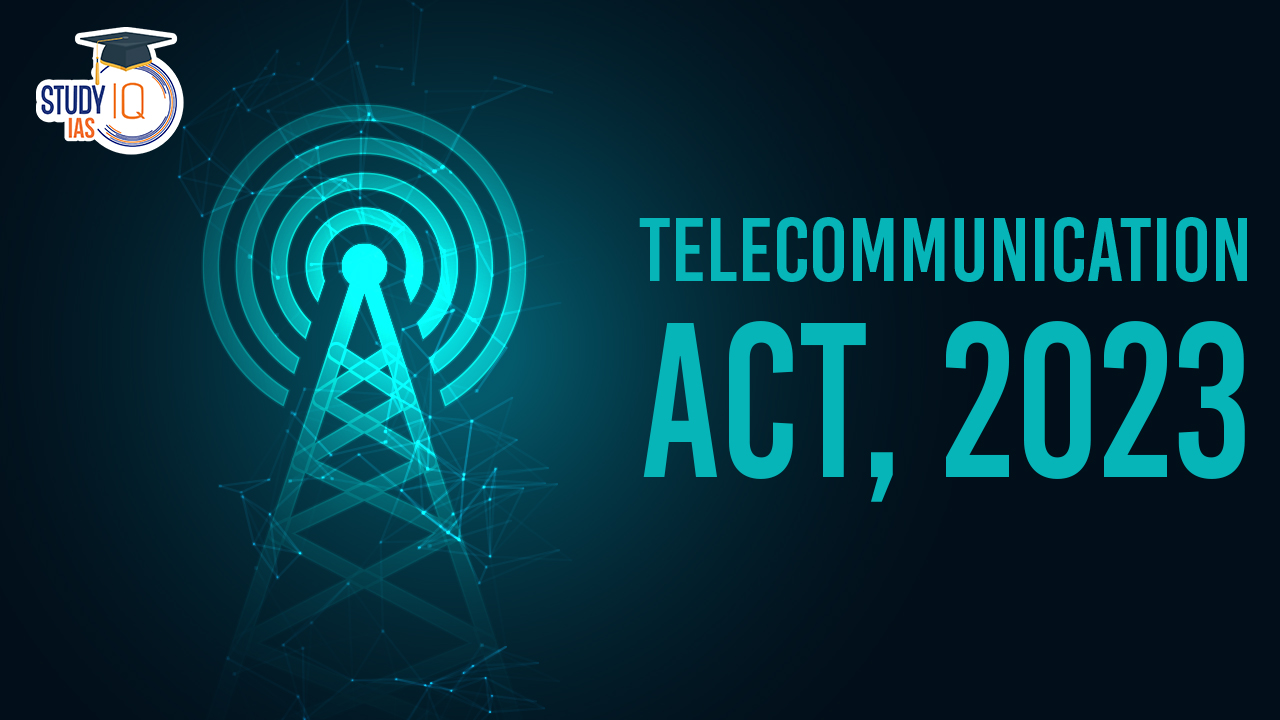Table of Contents
Context: The Telecommunications Act 2023 under its safety and emergency measures grants the government broad powers potentially compromising citizen privacy with limited oversight.
Key Highlights of the Telecommunications Act 2023
| Aspect | Details |
| Authorization for Telecom Activities | Central government authorization required for providing telecommunication services, establishing/operating/maintaining/expanding telecommunications networks, and possessing radio equipment. |
| Assignment of Spectrum |
|
| Interception of Messages | Interception is permitted for the security of the state, prevention of incitement of offences, and maintenance of public order. |
| Suspension of Telecom Services | The central government can temporarily control telecom services in emergencies for national security. |
| Guidelines for Press Messages | Accredited press messages are not to be intercepted/detained unless prohibited under applicable rules. |
| Adjudication Mechanism |
|
| Guidelines for Unutilised Spectrum |
|
| Standards Specification | Central government to set standards for telecom equipment, infrastructure, networks, and services. Equipment procurement from trusted sources. |
| Protection of Users | Measures include consent for specific message types and reporting mechanisms for malware or specified messages. |
| Appointments to TRAI | Chairperson with at least 30 years, and members with at least 25 years of professional experience. |
| Priority Transmission during Disasters | Temporary seizure of telecom services by the government for public emergencies, with priority transmission for authorised users. |
| Digital Bharat Nidhi | The Universal Service Obligation Fund provided for telecom services in underserved areas renamed as Digital Bharat Nidhi, and also allows its use for research and development in telecom. |
We’re now on WhatsApp. Click to Join
Significance Of The Telecommunications Act 2023
- Modernising Archaic Laws: Seeking to modernise telecom laws such as the Indian Telegraph Act (1885), the Wireless Telegraphy Act (1933), and the Telegraph Wires (Unlawful Possession) Act (1950) to adapt to the sector’s evolution.
- Clarifying Satellite Broadband Services: The Bill is a game-changer for satellite broadband in India, bringing clarity, boosting remote connectivity, and attracting global players, startups, and investment.
- Reducing Executive Discretion: The Bill refines spectrum assignment processes, eliminating the earlier draft’s vague “any other manner as may be prescribed” clause.
- It now limits spectrum assignment strictly to auctions or administrative processes, enhancing transparency and predictability in spectrum management.
- Embracing Technology for Governance: Introduction of technology-driven solutions like online dispute resolution, streamlining grievance redressal expected to facilitate ease of doing business in the telecom sector.
- Simplifying Bureaucratic Procedures: It simplifies procedures for telecom operators in acquiring licences and permits through digitization.
- Promoting regulatory stability and fostering a conducive environment for telecom expansion.
- Exclusion of OTT Services: Notably, the Bill consciously refrains from extending its jurisdiction to telecom-adjacent services, like Over-The-Top (OTT) platforms.
- This avoided potential overregulation, ensuring a balanced approach to managing the dynamic telecom sector.
Challenges Associated with Telecommunications Act 2023
- Executive Misuse Potential: The Bill’s expansive provisions for the Centre to commandeer or suspend telecom services and networks for national security or in wartime, and its clauses for message interception and service suspension during public emergencies, raise concerns about potential executive overreach.
- Privacy and Surveillance Issues: Provisions allowing the government to set and enforce standards for encryption and data processing in telecom stir privacy fears, particularly regarding the possibility of hindering encryption on popular messaging apps, thus infringing on user privacy rights.
- Legal Hurdles in Administrative Spectrum Allocation: The Bill’s ‘administrative allocation’ of spectrum may conflict with the Supreme Court’s 2012 recommendation for auctioning scarce resources, as established in the 2G spectrum case, potentially inviting legal challenges.
- Vagueness in Definitions: The Bill’s broad and ambiguous definitions of telecom, telecom services, and messages could lead to wide interpretations, possibly extending regulatory reach to online platforms, including messaging and OTT services.
Way Forward
- Enhanced Oversight: Implementing checks and balances is essential. Executive actions should only be initiated during a national emergency as defined under Article 352 of the Constitution and should require Parliamentary sanction.
- Upholding Privacy Rights: Adjustments in the Bill are needed to ensure alignment with fundamental rights, particularly the right to privacy, in the context of message interception and service suspension.
- Commitment to Transparency: The government should approach privacy issues proactively and transparently, given the extensive authority the Bill confers. This includes conducting rule-making processes with full transparency and stakeholder engagement.
- Inclusive Consultation Process: A comprehensive consultation involving all relevant parties, including private entities and the public, is crucial for refining the current draft of the Bill.


 Utkal Divas 2025: Odisha Foundation Day ...
Utkal Divas 2025: Odisha Foundation Day ...
 Transfer and Removal Process for High Co...
Transfer and Removal Process for High Co...
 List of Military Exercises of India 2024...
List of Military Exercises of India 2024...





















